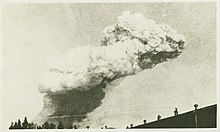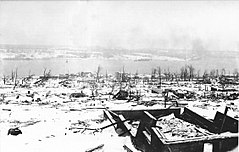Our was the Halifax explosion…the recounting of the shear power of it is staggering…
Explosion[edit]

Blast cloud of the explosion

Plan showing the radius of the explosion

A view across the devastation of Halifax two days after the explosion, looking toward the Dartmouth side of the harbour. Imo is visible aground on the far side of the harbour.
External audio
 Determining 9:04:35 a.m. as the precise time of the Halifax Explosion, 6:54, 4 December 1992, CBC Archive[57]
Determining 9:04:35 a.m. as the precise time of the Halifax Explosion, 6:54, 4 December 1992, CBC Archive[57]
At 9:04:35 am the out-of-control fire on board Mont-Blanc set off her cargo of high explosives.[58] The ship was completely blown apart and a powerful blast wave radiated away from the explosion initially at more than 1,000 metres (3,300 ft) per second. Temperatures of 5,000 °C (9,000 °F) and pressures of thousands of atmospheres accompanied the moment of detonation at the centre of the explosion.[59][27] White-hot shards of iron fell down upon Halifax and Dartmouth.[60] Mont-Blanc 's forward 90-mm gun landed approximately 5.6 kilometres (3.5 mi) north of the explosion site near Albro Lake in Dartmouth with its barrel melted away, and the shank of Mont-Blanc 's anchor, weighing half a ton, landed 3.2 kilometres (2.0 mi) south at Armdale.[61]
A cloud of white smoke rose to at least 3,600 metres (11,800 ft).[62] The shock wave from the blast travelled through the earth at nearly 23 times the speed of sound and was felt as far away as Cape Breton (207 kilometres or 129 miles) and Prince Edward Island (180 kilometres or 110 miles).[27][63] An area of over 160 hectares (400 acres) was completely destroyed by the explosion,[61] and the harbour floor was momentarily exposed by the volume of water that was displaced. A tsunami was formed by water surging in to fill the void;[64] it rose as high as 18 metres (60 ft) above the high-water mark on the Halifax side of the harbour.[65] Imo was carried onto the shore at Dartmouth by the tsunami.[66] The blast killed all but one on the whaler, everyone on the pinnace and 21 of the 26 men on Stella Maris; she ended up on the Dartmouth shore, severely damaged. The captain’s son, First Mate Walter Brannen, who had been thrown into the hold by the blast, survived, as did four others.[67] All but one of the Mont-Blanc crew members survived.[68]
Over 1,600 people were killed instantly and 9,000 were injured, more than 300 of whom later died.[27] Every building within a 2.6-kilometre (1.6 mi) radius, over 12,000 in total, was destroyed or badly damaged.[64] Hundreds of people who had been watching the fire from their homes were blinded when the blast wave shattered the windows in front of them.[69] Stoves and lamps overturned by the force of the blast sparked fires throughout Halifax,[70] particularly in the North End, where entire city blocks were caught up in the inferno, trapping residents inside their houses. Firefighter Billy Wells, who was thrown away from the explosion and had his clothes torn from his body, described the devastation survivors faced: “The sight was awful, with people hanging out of windows dead. Some with their heads missing, and some thrown onto the overhead telegraph wires.” He was the only member of the eight-man crew of the fire engine Patricia to survive.[71]
Large brick and stone factories near Pier 6, such as the Acadia Sugar Refinery, disappeared into unrecognizable heaps of rubble, killing most of their workers.[4] The Nova Scotia cotton mill located 1.5 km (0.93 mile) from the blast was destroyed by fire and the collapse of its concrete floors.[72] The Royal Naval College of Canada building was badly damaged, and several cadets and instructors maimed.[73] The Richmond Railway Yards and station were destroyed, killing 55 railway workers and destroying and damaging over 500 railway cars. The North Street Station, one of the busiest in Canada, was badly damaged.[74]

View from the waterfront looking west from the ruins of the Sugar Refinery across the obliterated Richmond District several days after the explosion. The remains of Pier 6, site of the explosion, are on the extreme right.
The death toll could have been worse had it not been for the self-sacrifice of an Intercolonial Railway dispatcher, Patrick Vincent (Vince) Coleman, operating at the railyard about 750 feet (230 m) from Pier 6, where the explosion occurred. He and his co-worker, William Lovett, learned of the dangerous cargo aboard the burning Mont-Blanc from a sailor and began to flee. Coleman remembered that an incoming passenger train from Saint John, New Brunswick, was due to arrive at the railyard within minutes. He returned to his post alone and continued to send out urgent telegraph messages to stop the train. Several variations of the message have been reported, among them this from the Maritime Museum of the Atlantic: “Hold up the train. Ammunition ship afire in harbor making for Pier 6 and will explode. Guess this will be my last message. Good-bye boys.” Coleman’s message was responsible for bringing all incoming trains around Halifax to a halt. It was heard by other stations all along the Intercolonial Railway, helping railway officials to respond immediately.[75][76] Passenger Train No. 10, the overnight train from Saint John, is believed to have heeded the warning and stopped a safe distance from the blast at Rockingham, saving the lives of about 300 railway passengers. Coleman was killed at his post.[75] He was honoured with a Heritage Minute in the 1990s, inducted into the Canadian Railway Hall of Fame in 2004,[77] and a new Halifax-Dartmouth Ferry was named for him in 2018.[78]




